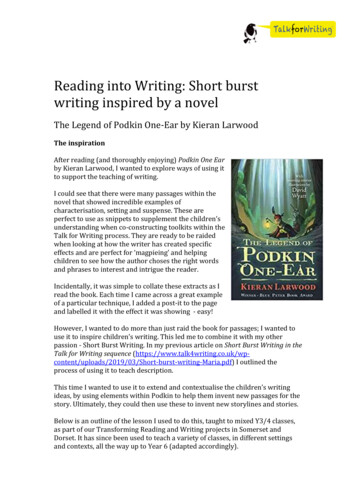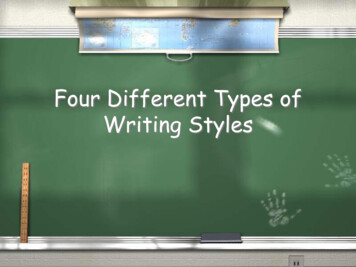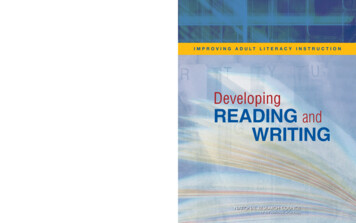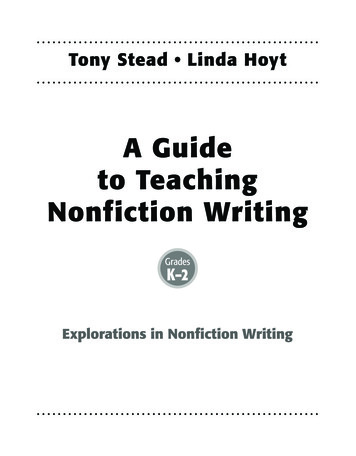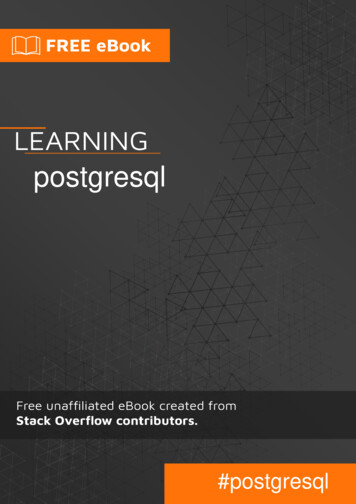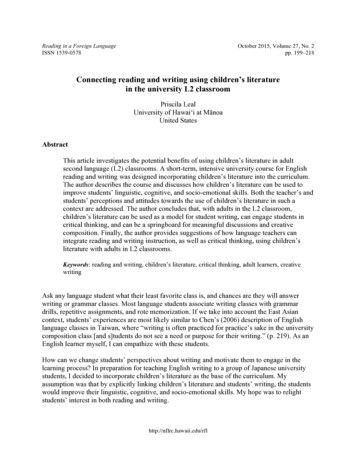
Transcription
Reading in a Foreign LanguageISSN 1539-0578October 2015, Volume 27, No. 2pp. 199–218Connecting reading and writing using children’s literaturein the university L2 classroomPriscila LealUniversity of Hawai‘i at MānoaUnited StatesAbstractThis article investigates the potential benefits of using children’s literature in adultsecond language (L2) classrooms. A short-term, intensive university course for Englishreading and writing was designed incorporating children’s literature into the curriculum.The author describes the course and discusses how children’s literature can be used toimprove students’ linguistic, cognitive, and socio-emotional skills. Both the teacher’s andstudents’ perceptions and attitudes towards the use of children’s literature in such acontext are addressed. The author concludes that, with adults in the L2 classroom,children’s literature can be used as a model for student writing, can engage students incritical thinking, and can be a springboard for meaningful discussions and creativecomposition. Finally, the author provides suggestions of how language teachers canintegrate reading and writing instruction, as well as critical thinking, using children’sliterature with adults in L2 classrooms.Keywords: reading and writing, children’s literature, critical thinking, adult learners, creativewritingAsk any language student what their least favorite class is, and chances are they will answerwriting or grammar classes. Most language students associate writing classes with grammardrills, repetitive assignments, and rote memorization. If we take into account the East Asiancontext, students’ experiences are most likely similar to Chen’s (2006) description of Englishlanguage classes in Taiwan, where “writing is often practiced for practice’s sake in the universitycomposition class [and s]tudents do not see a need or purpose for their writing.” (p. 219). As anEnglish learner myself, I can empathize with these students.How can we change students’ perspectives about writing and motivate them to engage in thelearning process? In preparation for teaching English writing to a group of Japanese universitystudents, I decided to incorporate children’s literature as the base of the curriculum. Myassumption was that by explicitly linking children’s literature and students’ writing, the studentswould improve their linguistic, cognitive, and socio-emotional skills. My hope was to relightstudents’ interest in both reading and writing.http://nflrc.hawaii.edu/rfl
Leal: Connecting reading and writing using children’s literature200This article addresses Paran’s call for more teachers’ narratives and reflections “on what they doin class” (2008, p. 470). I begin by reviewing the main arguments for the use of literature in thesecond language (L2) classroom, followed by arguments specific to the use of children’sliterature with adult learners. Next, the study’s methodology is presented followed by its findings.A reflection of (a) the benefits of integrating children's literature, (b) students' perceptions, and (c)pedagogical implications concludes this article.Using Literature in the L2 ClassroomWhy Literature in the L2 Classroom?The role of literature in the L2 classroom has been a long-standing topic of debate in the field(see Paran, 2008 for a discussion of its pros and cons). Recent studies have discredited some ofthe most common arguments teachers, administrators, and publishers use to justify the exclusionof literature from the L2 classroom. Some argue that students can develop high levels oflanguage competence without any language production (Krashen, 1994). However, the studentsenrolled in my course were more interested in opportunities for output than input. In Japan, theirEnglish learning experience involved mostly listening and reading (input, Krashen, 1984); in thiscourse, their expectation was to focus on speaking and writing (output, Swain, 1985). Literaturecan serve both purposes: as input, it presents authentic language communication to students; asoutput, it can serve as a prompt and stimulate students to discuss, share, and write (Chen, 2006;see Belcher & Hirvela, 2001 for theoretical and practical perspectives on L2 reading-writingconnections). Weber-Fève (2009) addressed how an input-to-output approach can be combinedin an introduction to literature course, concluding that by building a continuum from pre-readingactivities (input), to oral interactions with peers and written reactions to texts (output), studentscould effectively explore stylistic and rhetorical writing conventions.Another common argument is that literature is only appropriate for advanced language students(Gower, 1986) due to its length, vocabulary difficulty, and complex plots. Several scholars haveprovided evidence that counters this belief. Walther (2007) proposed that literature be given agreater role in beginner courses as a model of how language works in context and to drawstudents’ attention to connections between language and communicative events.Sivasubramaniam (2006) addressed how literature can promote an elementary grasp of Englishto internalize vocabulary and grammar patterns. Its use can also promote critical thinking. AsVandrick (1996) argued, “a thinking person must analyze, question, interpret, synthesize whatshe or he hears and reads” (p. 27).Literature can serve as an alternative to using personal topics and life experiences as prompts fordiscussion and writing. Literature can provide purposeful and meaningful topics which “allow usto create the level of emotional involvement that we have been seeking in more personal,subjective topics without sacrificing the distance and objectivity that will encourage reader-basedprose” (Gajdusek & vanDommelen, 1993, p. 198). Therefore, literature can be a springboard forstudents to reflect on their lives, learning, and language.The fact that literature is virtually absent from English Language Teaching (ELT) textbooks (seeReading in a Foreign Language 27(2)
Leal: Connecting reading and writing using children’s literature201Gümüşok, 2013 for analysis of 22 ELT course books of different levels and different series) maydiscourage teachers, since the responsibility of selecting appropriate materials and designing ameaningful course falls entirely on them. Even if teachers are up to this challenge, they may feeldiscouraged by the difficult, old, and outdated vocabulary present in some literary texts (Khatib,Rezaei, & Derakhshan, 2011) and feel like literary English is not practical English. That shouldnot stop teachers from using literary texts because (a) students should not be expected to speak orwrite in the same way as literary texts, and (b) literary text “displays a broader range ofcommunication strategies than any other single ESL [English as Second Language] teachingcomponent” (Sage, 1987, p. 6). Teachers may also feel discouraged from using literature becausethey think they lack the knowledge to teach it. Perhaps, like many students, teachers may feeldiscouraged because of their own negative experiences with literature in their academic lives.However, if used meaningfully and purposefully (Crookes & Schmidt, 1991), literature canrevive students’ motivation (Donceva & Daskalovska, 2014; Sivasubramaniam, 2006; Van, 2009)and provide opportunities for creative work (Türker, 1991).Some scholars have focused on different approaches to teaching literature in the L2 classroom.Van (2009) classified these approaches into six categories: new criticism; structuralism; stylistics;reader-response; language-based; and critical literacy. Fernandez (2011) summarized Carter andLong’s models (cultural, language, and personal growth) and advocated for an integratedapproach of the three. Although scholars may disagree on which approach is the mostappropriate, they agree that when using literature in the L2 classroom, tasks should focus onprocess instead of product, on negotiation of meanings and interpretations instead of predetermined answers, and on students’ analysis instead of the teacher’s (Mourão, 2009). Thus,teachers should act as facilitators rather than lecturers. Van (2009) stated, “[the] teacher’s role isnot to impose interpretation but to introduce and clarify technical terms, prepare and offerappropriate classroom procedures, and intervene when necessary to provide prompts or stimuli”(p. 7).Other scholars investigated students’ attitudes and perceptions towards the use of literature in theL2 classroom. A potential critique of this research is that the use of literature in language courseshas no practical relevance since the focus of the research is mainly on students’ perceptions.Nevertheless, because we are teaching students, we should know what they think about thecontent we teach and about how we teach it. Çirakli and Kiliçkaya (2011) were interested in howsenior, pre-service language teachers in Turkey felt about the use of literature to improvelanguage skills, academic and occupational goals, and individual and cultural awareness.According to the participants, the instructor presented and analyzed most of the readingsassigned, and although they felt the nature of the course did provide a platform for discussion,the participants did not believe they had benefitted from it. Yilmaz (2012) also investigatedundergraduates’ attitudes towards the study of literature in Turkey and provided more insightsinto the factors most likely to affect students’ opinions. In Yilmaz’s study, 87.6% of the studentsreported ‘small group work’ to be the most useful approach for using literary texts in theclassroom; lecture was the least useful.Several studies have considered how teachers interact with students in the classroom, and how itmay affect students’ participation during whole class discussions about literary texts (Donato &Brooks, 2004; Mantero, 2006; Nance, 2002; Nassaji & Wells, 2000; Thoms, 2011). Nassaji andReading in a Foreign Language 27(2)
Leal: Connecting reading and writing using children’s literature202Wells (2000) explored literature classroom discourse in Canada and concluded that whenteachers showed genuine interest in students’ comments and asked them to expand on suchcomments, students were more willing to participate in whole class discussion. Donato andBrooks (2004) investigated an undergraduate Spanish literature class. They concluded thatproviding opportunities for discussion was not enough; teachers must structure the discussions ina way that stimulates students to speak at their level of language proficiency. Similarly to Nassajiand Wells, Donato and Brooks also encouraged teachers to present opportunities for the studentsto elaborate on their responses and promote participation in whole class discussion. A morerecent study by Thoms (2011) observed a Latin American literature college classroom in the USconducted in Spanish. Also similarly to Nassaji and Wells, Thoms found that the teacher’sreformulations have the potential to afford students the ability to understand the ongoing talkduring whole-class discussion. Thoms grouped teachers’ reformulations into three functions: (a)access-creating, when teachers make students’ comments accessible to all by repeating it to thewhole class; (b) funneling, when teachers ask students questions that move from very broad tospecific references; and (c) content-enhancing, when teachers make linguistic corrections whileat the same time demonstrating appreciation for the students’ contributions.Why Use Children’s Literature for Adult Learners?Since many of the arguments for the use of children’s literature in the L2 classroom overlap withthe arguments discussed in the previous section, this section will focus specifically on thearguments directly related to the use of children’s literature with adult learners. First, children’sliterature can provide comprehensible input (Krashen, 1982) through content and style. Itsshorter length, simpler language, less complicated plots (Ho, 2000), and predictable, repeatedlanguage patterns (Smallwood, 1992) “can [help students] read and discuss in a reasonableamount of class time and students can get a feeling of achievement and satisfaction quickly”(Vandrick, 2003, p. 273). Teachers may associate these characteristics with the children’sliterature often depicted in picture books targeted to younger learners, but that is not always thecase.Most folklore was originally written for adults. Recently, there has been a renewed interest infairytales, a sub-genre of children’s literature (Knowles & Malmkjaer, 2002). Fairytales havebeen made popular again by TV shows and big production films, as is the case with Little RedRiding Hood (LRRH)–the story discussed in this article. The 1987 Broadway musical Into theWoods (which features LRRH among other fairytales) was adapted in 2014 and is now a motionpicture. In 2005, the computer-animated film Hoodwinked! was released; its plot retells LRRH asa police investigation, using flashbacks to show multiple characters’ points of view. In 2011, onemotion picture and two TV series featured versions of LRRH’s plot: the film Red Riding Hood;the pilot episode of NBC's Grimm; and, ABC's Once Upon a Time. Such TV shows and filmproductions are not targeted at children but at adults.Two recent studies in particular address the use of children’s literature with adult learners. Ho(2000) used children’s literature with three groups of twenty freshman undergraduates fromChina. Ho addressed the issue of adult learners not relating to child protagonists but, in spite ofthat, children’s literature was still effective in teaching linguistic skills and improving languageacquisition. In addition, she noticed that students often found academic text discussionsReading in a Foreign Language 27(2)
Leal: Connecting reading and writing using children’s literature203intimidating because they felt they lacked the language skills to participate spontaneously, butthey felt more comfortable discussing children’s literature. Ho stated, “using children’s literaturehas succeeded in encouraging them [students] to voice their opinions compared to otherclassroom group discussions that use academic texts” (2000, p. 264). In a different context,Davidheiser (2007) used children’s literature in college level introductory German courses. Hepresented an instructional sequence focused on students’ language development: from true/falseand yes/no questions for listening development, to sentence creation for grammar development,to retelling activities for oral and written language development.Connecting Reading and Writing with Children’s LiteratureThe CourseThe data in this article are part of a larger study. The data were produced and collected duringthe course English Reading and Writing, which I taught in the spring of 2014 as part of anintensive, short-term program at a university in Hawai‘i. The data for the larger study included30 hours of audio recordings, the teacher’s reflective journal, questionnaires, and studentartifacts (such as journals entries and writings) collected during the four-week course. The datawere collected as part of my professional development and their use approved by the Universityof Hawai‘i at Mānoa’s Social and Behavioral Sciences Institutional Review Board (IRB). Thegoals of the course, as reflected in the syllabus, included: improving reading and writing skills;working cooperatively with others in whole class, small group, and pair discussions; and,developing and demonstrating analytical and critical thinking skills.ParticipantsThe Intensive Language Program (ILP)1, within which this course is situated, is designed forinternational university students who come to Hawai‘i temporarily to learn English and thenreturn to their home countries. The eight Japanese university students enrolled in the courseexpressed that the main reason for them learning English was to ‘talk to foreigners’ and ‘to workabroad.’ Initial questionnaire responses revealed (a) preference for working in small groups, (b)preference for speaking opportunities, and (c) dislike for studying grammar. All students were inthe low-intermediate level based on the institutional placement test. There were four female andfour male students between the ages of 21 and 26. Their majors ranged from the natural sciences,to education, to tourism.Initial students’ journal entries showed that these students were not accustomed to any forms ofexperiential dialogical pedagogy. Students described having had classes where they haddiscussed comprehension questions (e.g., ‘what does the writer mean in this section?’) but hadnot shared their own opinions about the text.MaterialsThe materials for this course included two different versions of the fairytale commonly known asLRRH. The selection of this particular story was based on the assumption that studying a familiarReading in a Foreign Language 27(2)
Leal: Connecting reading and writing using children’s literature204story, one which had been (re)interpreted in movies and TV shows, would help studentsunderstand that literature is neither useless nor faraway and that literature is part of our life.Because the plot would be known to all, students would not need to worry about understandingits content. Instead, they would be able to focus on its form and on improving their criticalthinking skills.The first version introduced was Charles Perrault’s, often deemed the first published versionfrom 1697. In Perrault’s version, the story ends with the grandmother and LRRH being eaten bythe wolf. The second version introduced was Jacob and Wilhelm Grimm’s (aka the BrothersGrimm). This version was published 150 years after Perrault’s and is perhaps the most popularlyknown version. In the Brothers Grimm’s version, the story picks up where Perrault’s ends, whena huntsman comes to LRRH and her grandmother’s rescue and finds the wolf asleep. Thehuntsman then cuts open the wolf’s belly, saving the two women, and fills the wolf’s belly withlarge stones.Curriculum and Lesson PlanThe curriculum included scaffolding tasks that would progressively prepare the students toengage in discussing texts, author’s perspectives, and each other’s opinion. These tasks wouldalso serve to foster a safe place and a welcoming community. Another purpose was to awakenstudents’ critical thinking capacities since, as previously mentioned, these students had yet toexperience dialogical pedagogy. Laying the foundation to achieve such goals meant introducingthe curriculum in a low-anxiety way and using content with no controversial topics. Because ofthe length of this course, these foundational tasks needed to be carried out in a manner in whichstudents would not spend too much time learning the content but would instead practice the skillsthat would gradually lead them to experiencing critical thinking. Therefore, the order of the taskswas relevant for this course (see Figure 1).Figure 1. LRRH tasks’ cyclePre-reading tasks had the purpose of activating students’ schemata, during-reading tasks focusedon text’s content and form, and post-reading tasks gauged students’ comprehension andReading in a Foreign Language 27(2)
Leal: Connecting reading and writing using children’s literature205encouraged critical thinking and creativity. The task order was also important in promoting theuse of both oral and written languages to inform, discuss, question, negotiate, and communicatewith others. Lessons proceeded in the following way (see Table 1):Table 1. Lesson progressionPhase 1LRRH by PerraultTeacher and students take turns reading aloud each paragraphStudents identify unfamiliar words in the textStudents write one word per sticky note and post them on the white board. Sameunknown words go on top of each other. Students familiar with a word areencouraged to explain to classmates its definition related to its use in the text.Fill in vocabulary logUsing the new vocabulary, pairs generate and discuss knowledge questionsQuestions are exchanged with another pair and discussedAll questions are posted on the white board and pairs report to the whole classMy favorite character activityDraw favorite character and describe three reasons why it is your favoriteRewriting grammar, rewrite the first paragraph of Perrault’s versionChange verbs from the past tense to the present tense; check/review your partner’sPhase 2Little Red Cap by Brothers GrimmStudent-pairs take turns reading aloud each paragraphStudents identify unfamiliar words in the textStudents write one word per sticky note and post them on the white board. Sameunknown words go on top of each other. Students familiar with a word areencouraged to explain to classmates its definition related to the use in the text.Fill in vocabulary logUsing the new vocabulary, pairs generate and discuss evaluation questionsQuestions are exchanged with another pair and discussedAll questions are posted on the white board and pairs report to the whole classRewriting grammar, rewrite the last two paragraphs of Brothers Grimm’s versionChange verbs from the past tense to the future tense; check/review your partner’sPhase 3Compare and contrast storiesWhat are the similarities and differences between the two versions?With a partner, complete the comparing table and then a Venn diagramVocabulary review/worksheetIn pairs, create as many sentences in the least amount of time using the 22-word listPhase 4Retelling LRRHChoose between writing an alternative ending or writing from a character’sperspectiveShare your version with a partner. Then, interview each other by asking two evaluativequestions and reporting your partner’s answers in your journalPhase 5Japanese Tale – Part ISelect a Japanese tale of your choice to modify the end. In your journal, write thename of the story, its original version, and how you plan to change itShort story structure instruction (diagram)Reading in a Foreign Language 27(2)
Leal: Connecting reading and writing using children’s literature206Japanese Tale – Part IIIn your journal, explain why you chose this story and why you want to change itWrite your story until the climaxJapanese Tale – Part IIIWrite the end/conclusion of your storyJapanese Tale – Part IVRead your partner’s story. Evaluate her/his story based on (a) organization, (b) plot(story), and (c) goal (moral) by using the following point system: 1 needsimprovement; 2 so so; 3 goodShare your own story with the whole classHow Can Children’s Literature Be Used in the L2 Classroom?This section presents the findings from the reading and writing tasks based on the three versionsof LRRH discussed during the course: Charles Perrault’s, the Brothers Grimm’s, and eachstudent’s version. I present evidence of how children’s literature has the potential to improvestudents’ linguistic, cognitive, and socio-emotional skills. I interweave teacher and studentperceptions and attitudes into the analysis.Enhancing Linguistic SkillsAs students participated in the vocabulary task of identifying unknown words and sharing theirknowledge with others, they learned word definitions from each other and a comfortableenvironment began to form. Students understood early on that (a) in this class everyone spoke,and (b) everyone had something to learn from someone else, just as everyone had something toteach others. This sharing of vocabulary was viewed positively by most students, as Makoto’scomment illustrates:Sharing unknown words is matching to me. I can find it and I can know other people’sunknowing words. Also we explain each other words so it is very beneficial to me.Each new vocabulary word was logged in the students’ individual logs along with its part ofspeech and a sentence created by the student. After Charles Perrault’s and the Brothers Grimm’sversions of LRRH had been studied, I prepared a vocabulary review containing 22 words, whichhad been previously identified by the students as unknown. In this task, students, with a partner,were to create as many sentences as possible using the words in the worksheet in the leastamount of time. By pairing students with lower vocabulary fluency with students with highervocabulary fluency, the results among the pairs were comparable: three pairs scored 15 points,and one pair scored 14 points out of 22 possible points.Final questionnaire responses reflected students’ perception of vocabulary increase. Using a 5point scale, students were asked whether they agreed with the statement, ‘I believe the groupwork in this course helped me understand more about English reading texts.’ The response wasoverwhelmingly positive. Of the eight students, seven strongly agreed and one agreed. Theiranonymous commentaries reflect such perception:Reading in a Foreign Language 27(2)
Leal: Connecting reading and writing using children’s literature207We learned a lot of vocabulary.We checked unknowing words so I could understand texts smoothly.I became happy with friends so I believe that group work connect understand more about English.With regards to which tasks better supported the students in such vocabulary gain, Makoto’scomment represents most of the students’ beliefs:And then, sharing own opinion is also like [that] because I always finish just thinking I have toshare my opinion so I consider ‘what should I say?’ ‘what words should I use?’; it is importantfor me.Makoto saw this task of sharing opinions as an opportunity to expand her vocabulary andgrammatical knowledge, by searching for expressions that would better represent her thoughts inEnglish. She continued: it is difficult for me to express my opinion in English so this assignment is good practice. If Idon’t know words, grammar and expression, I try to search a correct. This process is importantand beneficial to me.Children's literature can be used as a model for writing as evidenced by the students’ retellings.Text structure, grammar, and vocabulary were appropriated by the students based on the versionof the LRRH version they used as the base for their rewriting. Kanta’s retelling began with thelast line of Perrault’s version but with a change in verb form–from ‘the wolf ate her all up’ to‘the wolf was going to eat her.’ In Kanta’s retell, LRRH was a ‘judo fighter and very intelligent’and defeated the wolf with a powerful punch which led him to vomit grandmother. FollowingPerrault’s version, Kanta appropriated words like ‘belly’ and ‘woodcutters,’ whereas studentswho used the Brothers Grimm’s version used words like ‘body’ and ‘huntsman.’ Sumiya alsoused Perrault’s version as the springboard for his story. Sumiya began his story after the wolfhad eaten grandmother and LRRH, and went outside to eat the woodcutter. The wolf then wentto LRRH’s house and pretended to be LRRH. Her mother was not fooled and killed him as thewolf opened the door. LRRH’s mother opened the wolf’s belly and saved LRRH, grandmother,and the woodcutter. Sumiya used some of the new words from the vocabulary log such as: belly,counterfeit (as in the wolf counterfeiting his voice), doted (e.g., ‘The grandmother doted but themother didn't dote’), and bobbin and latch (e.g., ‘Pull the bobbin and the latch will go up’). Itwas evident that students’ vocabulary choices were based on the story they selected as the modelfor their rewrite.It is also possible to find evidence of appropriated structure. Kimie narrated her story based onPerrault’s version from the moment ‘Little Red Riding Hood pulled the bobbin, and the dooropened. The wolf, seeing her come in, said to her–I haven't seen you in a long time!’ Whatfollowed was a story rich in imagery and dialogue. Sometimes, almost bordering on plagiarism,students appropriated the whole structure of their selected version. Hoshihiko used the samestructure as the Brothers Grimm’s version and the word choice was almost verbatim, but it wasnot. It was possible to still recognize the original story in light of Hoshihiko’s adaptation. Hisversion began by repeating the Brothers Grimm’s sentences but exchanging the qualities andReading in a Foreign Language 27(2)
Leal: Connecting reading and writing using children’s literature208imageries into antonyms (see Table 2).Table 2. Comparison between student’s and original versionsThe Brothers Grimm’s versionHoshihiko’s versionOnce upon a time there was a sweet little girl.Once upon a time there was an ugly little girl.Once she gave her a little cap made of red velvet.Once she gave her a little cap made of brownvelvet.When Little Red Cap entered the woods a wolfWhen Little Red Cap entered the woods acame up to her.wolf came up to her.‘Good day to you, Little Red Cap.’Good morningThe wolf thought to himself, ‘Now there is a tastyThe wolf went on his way minding his ownbite for me. Just how are you going to catch her?’businessHoshihiko’s plot began to distance from the original version when LRRH and the wolf met in theforest, and the wolf went on with his business uninterested in LRRH. The rest of the story wasuneventful, and LRRH arrived at grandmother’s home unharmed and they have a good timetogether. This uneventfulness and lack of climax led me to explicitly discuss the elements of theshort story’s plot prior to the final assignment (rewriting a Japanese tale) with the hope thatstudents would create more interesting and catchy storylines—and they did (see EnhancingSocio-Emotional Skills section).The students’ journals were another area where it was possible to witness significantimprovement in their linguistic skills. Students were given prompts during class to be completedas homework. This was so they would feel more in control of the content and quantity of theirentries. Most students’ entries were initially very short. They were composed of either loosesentences without paragraph structure or just bullet points. As I grew to know the studentsthrough their journals and encouraged them not to hold back, the increase in the quantity andquality of content was apparent. The entries seemed genuin
Leal: Connecting reading and writing using children’s literature 200 Reading in a Foreign Language 27(2) This article addresses Paran’s call for more teachers’ narratives a
